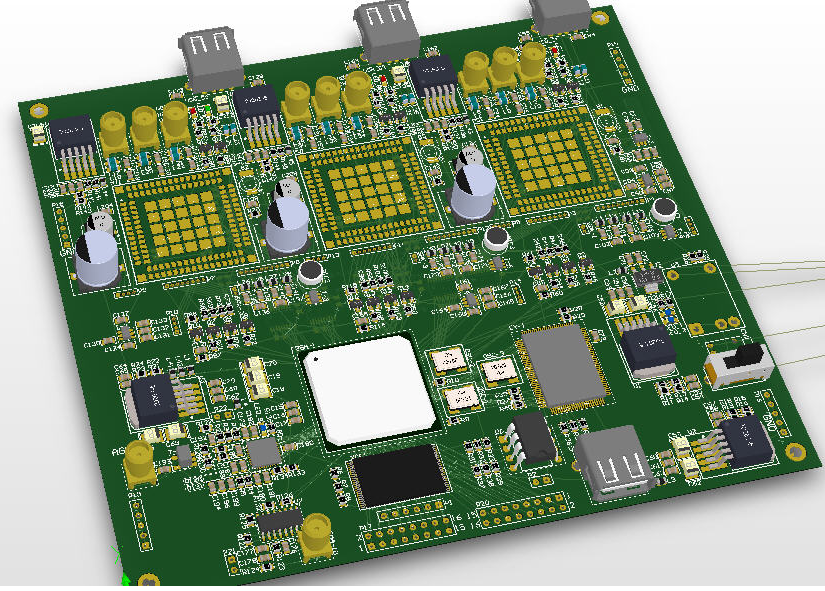The upstream of the printed circuit board manufacturing industry is mainly copper foil, copper foil substrate, glass fiber cloth, resin and other raw materials industries; the downstream is mainly electronic consumer products, automobiles, communications, aerospace and other industries. The printed circuit board manufacturing industry has a long industrial chain. Special wood pulp paper, electronic grade glass fiber cloth, electrolytic copper foil, CCL (copper clad laminate) and PCB (printed circuit board) are closely connected and interdependent on the same industrial chain. Upstream and downstream products.
Printed circuit boards are widely used in communications, optoelectronics, consumer electronics, automobiles, aerospace, military, industrial precision instruments and many other fields. They are indispensable electronic components in modern electronic information products. The development level of the printed circuit board industry can be To a certain extent, it reflects the development speed and technical level of a country or region's electronics industry.
PCB is highly dependent on upstream industries, especially copper clad laminate (CCL). Copper clad laminates are the most expensive item of PCB single material cost, accounting for about 30% of the material cost.
Copper clad laminate is an extremely important basic material for printed circuit boards. Printed circuit boards of various forms and functions are selectively processed, etched, drilled and copper plated on the copper clad laminate to make different types of printed circuit boards. Printed circuit. As the substrate material in the manufacture of printed circuit boards, copper clad laminates mainly play the role of interconnection, insulation and support for the printed circuit board, and have a great impact on the transmission speed, energy loss and characteristic impedance of the signal in the circuit. . Therefore, the performance, quality, processability in manufacturing, manufacturing level, manufacturing cost, and long-term reliability and stability of the printed circuit board depend to a large extent on the copper clad laminate.
At the same time, copper clad laminates have the strongest bargaining power in the upstream and downstream industrial chain structure. Not only do they have a strong voice in the procurement of raw materials such as fiberglass cloth and copper foil, but also as long as the downstream demand is sufficient, the pressure of rising costs can be passed on To downstream PCB manufacturers.
There are many PCB classification methods. According to the number of circuit layers, there are single-sided, double-sided and multi-layer boards; according to the medium, there are flexible boards(FPC), rigid boards (RPCB) and rigid-flex board (RFPC); Material classification, including glass fiber cloth substrate, ceramic substrate, metal substrate, etc.

PCB is a bridge that carries electronic components and connects circuits. It is widely used in communication electronics, consumer electronics, computers, automotive electronics, industrial control, medical equipment, national defense, aerospace and other fields. The downstream industry has a greater traction and driving effect on the development of the PCB industry, and its demand changes directly determine the future development of the PCB industry.
In the past ten years, the global PCB market has a compound annual growth rate of 2.12%, which is mainly due to the great development of the consumer electronics industry. The annual compound growth rate of the PCB market in 2007-12 was 2.91%, and that in 13-17 was due to smartphones. The growth rate of shipments slowed down, and the compound annual growth rate of the PCB market dropped to 1.34%.
In 2017, the largest PCB application market was computers, accounting for 23.8%, and the second largest market was mobile phones, accounting for 23.7%. It is expected that communication base stations, automobiles, and consumer electronics will grow rapidly in the next 3-5 years, 2017-2022 The annual compound annual growth rate will reach 4.9%, 4.8%, and 4.7% respectively.
It is predicted that the growth rate of the computer application market will slow down and the proportion will gradually decline. By 2022, the proportion will decline from 26.2% in 2017 to 23.8%, and the proportion of the automotive application market will increase from 9.1% in 2017 to 9.8%., Communication base stations will increase from 4.3% in 2017 to 4.7%.